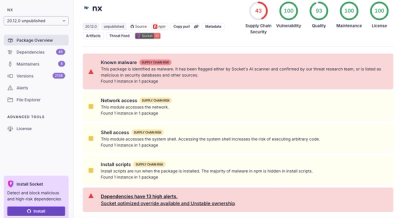
Security News
/Research
Wallet-Draining npm Package Impersonates Nodemailer to Hijack Crypto Transactions
Malicious npm package impersonates Nodemailer and drains wallets by hijacking crypto transactions across multiple blockchains.
DecoVal is a decorator-driven validation pattern that allows you to add validation rules directly to the properties of TypeScript classes, simplifying data control and increasing code readability and reusability.
DecoVal is a decorator-driven validation pattern that allows you to add validation rules directly to the properties of TypeScript classes, simplifying data control and increasing code readability and reusability.
Author: Kaike Bartolomeu
NPM Package: decoval
official documentation: decoval-docs
npm install decoval
yarn add decoval
pnpm add decoval
Enable decorators in TypeScript by adding the below options to tsconfig.json:
{
"compilerOptions": {
"experimentalDecorators": true,
"emitDecoratorMetadata": true
}
}
This example uses Decoval decorators to validate a User model with strict input rules: username requires a number and no spaces, password needs a special character and no spaces, and status must be a boolean. Ideal for secure login or account creation flows.
import "reflect-metadata";
import { DvText, DvBoolean, decoValidation } from "decoval";
class User {
@DvText({ noSpaces: true, number: true })
username!: string;
@DvText({ emailProviders: ["gmail.com", "yandex.com"] })
email!: string;
@DvText({ specialChar: true })
password!: string;
@DvBoolean()
status!: boolean;
}
This example shows how to use the decoval library with Express.js to validate data from a POST request. The User class uses @DvText decorators to define validation rules for name, email, and password. The decoValidation function automatically validates the data based on these annotations. If the data is valid, the server returns validated JSON; otherwise, it issues a 400 error. This approach keeps validation separate from routing logic, making it easier to reuse and organize code in modern REST APIs.
import express, { Request, Response } from "express";
import cors from "cors";
import morgan from "morgan";
import { DvText } from "./dv/dv.text";
import { decoValidation } from "decoval";
const app = express();
app.use(express.json()).use(cors()).use(morgan("dev"));
class User {
@DvText()
name!: string;
@DvText({ specialChar: true })
password!: string;
@DvText({ emailProviders: "gmail.com" })
email!: string;
}
type TUser<T> = {
[K in keyof T]: T[K];
};
app.post("/", async (req: Request<{}, {}, TUser<User>>, res: Response) => {
try {
const { email, name, password } = req.body;
const user = new User();
user.email = email;
user.name = name;
user.password = password;
const data = await decoValidation(user);
res.status(201).json(data);
} catch (error) {
res.status(400).json(error);
}
});
const port: number = 4000;
app.listen(port, () => console.log(port));
DecoVal is a robust and simple solution for data validation in TypeScript applications. With an elegant decorator-based syntax, it offers rich validations that are adaptable to the real business context.
📬 Contributions and suggestions are welcome! 🔗 Official repository: github.com/kaikebartolomeu/decoval
FAQs
DecoVal is a decorator-driven validation pattern that allows you to add validation rules directly to the properties of TypeScript classes, simplifying data control and increasing code readability and reusability.
The npm package decoval receives a total of 2 weekly downloads. As such, decoval popularity was classified as not popular.
We found that decoval demonstrated a healthy version release cadence and project activity because the last version was released less than a year ago. It has 1 open source maintainer collaborating on the project.
Did you know?

Socket for GitHub automatically highlights issues in each pull request and monitors the health of all your open source dependencies. Discover the contents of your packages and block harmful activity before you install or update your dependencies.

Security News
/Research
Malicious npm package impersonates Nodemailer and drains wallets by hijacking crypto transactions across multiple blockchains.

Security News
This episode explores the hard problem of reachability analysis, from static analysis limits to handling dynamic languages and massive dependency trees.

Security News
/Research
Malicious Nx npm versions stole secrets and wallet info using AI CLI tools; Socket’s AI scanner detected the supply chain attack and flagged the malware.